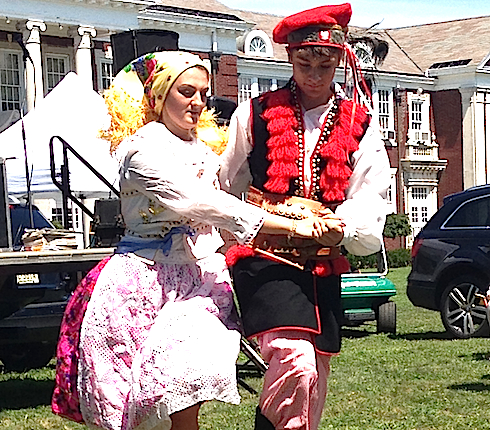Traditional wedding at modern day Polish Festival

Weddings are in the details. There are dress colors and flower types, themes and dancing. The same is true at the mock wedding hosted Saturday by the Polish Town Civic Association during its annual Polish Town Fair and Polka Festival.
Except the “couple” doesn’t have to fuss with making of any of choices. They follow strict tradition — Polish tradition.
The wedding highlights the customs of a traditional Polish ceremony that dates back hundreds of years, according to festival chairwoman Karen Fleischman.
“It’s generational,” she said. “We have a lot of that here in Riverhead. It’s about carrying on family tradition.”
The nuptials begin sharply at noon with an exchanging of vows at St. Isidore’s Church in Riverhead.
Before long the celebration begins. The music starts up, the young couple and their wedding party march down the street and through the village. The parade consists of the maid of honor, the best man, the ring bearer, the flower girl, the parents of the bride and groom, the godmother and six young maidens.
During the 10-minute march, Polish heritage is on full display. The participants are adorned in traditional costume known as krakowiak, named for the Krakow region in Poland where native dress was thought to be uniquely colorful and festive. The members of the Polish Town Civic Association intricately bead the dresses, sparing no details in bringing the Polish tradition to life. Colorful ribbons are pinned to the back of the bride’s headdress, except for the color red, which was thought to cause the newly weds to fight for the rest of the lives.
Another charming quirk — the bride is expected to cry. If she did not, it was believed she would cry through her marriage.
Then it is time for the most important and oldest of the wedding customs. The bride’s hair is unbraided and cut signifying the loss of her life as a single girl and the passing into her new life as a married woman. Of course, this is done using a wig during Saturday’s reenactment.
Finally, it’s time to hit the dance floor for a tradition that takes months of modern day training.
The volunteer bridal party, representing the St. Maximilian Kolbe Polish Dance Group, perfected the traditional wedding dance known as the Grand Polonaise.
“They did a wonderful job,” Ms. Fleischman said. “They practiced for hours. It was a big commitment.”
While most of those traditions have been lost to time, one still remains. The marrying couple is presented with a small piece of bread, sprinkled with salt and a small glass of wine.
The bread symbolizes that the couple shall not want or go hungry, the salt to represent the bitterness in life and the wine to show the sweetness of life.
“It’s one of those heart warming things that stood the test of time,” Ms. Fleischman said. “Some things never change.”







